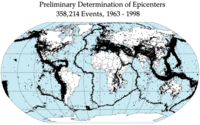
Photo from wikipedia
Quaternary deformation in the northern Chile forearc is controlled by trench parallel shortening along reactivated Mesozoic faults. Dextral strikes-slip is expressed in NW–SE striking faults of the Atacama Fault System,… Click to show full abstract
Quaternary deformation in the northern Chile forearc is controlled by trench parallel shortening along reactivated Mesozoic faults. Dextral strikes-slip is expressed in NW–SE striking faults of the Atacama Fault System, and reverse displacement dominates in E–W faults. This deformation results of the convergence in a concave-seaward continental margin. On September 11th, 2020, a Mw 6.3 earthquake and its subsequent aftershocks took place in the coastal region of northern Chile, revealing the reactivation of the deepest segment of a WNW–ESE striking upper plate fault. The reactivation of this fault occurred after the Mw 8.1 Iquique earthquake, and it seems to be connected to a N–S interplate locking segmentation of the plate margin, which is clearly shown by the locking pattern before the Iquique earthquake. This poses the question of how heterogeneous locking influences upper plate seismicity and how it relates to trench-parallel shortening.
Journal Title: Scientific Reports
Year Published: 2021
Link to full text (if available)
Share on Social Media: Sign Up to like & get
recommendations!